Unemployment and the need to support Upskilling

The scale and severity of the economic collapse almost fifteen years ago saw Ireland revert to the phenomenon of widespread unemployment. Despite the attention given to the banking and fiscal collapse, the transition from near full-employment to high unemployment was the most telling characteristic of that recession. It carried implications for individuals, families, social cohesion and the exchequer’s finances which were serious. At that time, the unemployment rate peaked at 16 per cent of the labour force at the beginning of 2012. Data and economic forecasts from the Central Statistics Office (CSO) for the remainder of 2023 indicate that unemployment will reach an annual rate of between 4.5 and 5 per cent of the labour force in 2023. The potential for an economic slowdown alongside the economic disruption from the Ukraine crisis point towards upwards risks for these expectations. However, relative to the position in late 2020 and early 2021 pandemic period these outcomes represent a very welcome improvement.
Recent Trends in Employment and Unemployment
The nature and scale of the recent transformation in Ireland’s labour market is highlighted by the data in Table 1. This, and subsequent Tables, examine the situation twelve years ago, just before the Covid-19 pandemic hit and in 2022. 2011 marked a year where Ireland was in deep economic crisis as the banking and property crash continued to unfold. Unsurprisingly, the labour market is transformed since then with an additional 460,000 people in the labour force, an extra 688,000 at work, higher participation rates and 228,000 less people in unemployment. Compared to the pre-pandemic labour market, the situation in quarter four 2022 illustrates how strongly the labour market has recovered from the period of closures and lockdowns throughout much of 2020. Although the numbers unemployed are slightly increased, all other indicators report a strong improvement.
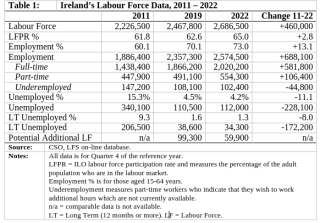
This transformation in the labour market has significantly altered the nature of employment in Ireland when compared to the depth of the recession in 2011. Overall, employment grew by over one-third (688,000 jobs) and Table 2 traces the impact of this change across various sectors, groups and regions. Within the CSO’s broadly defined employment sectors all bar agriculture increased in size over the period. The service sector, one acutely impacted by the 2009-2013 economic crash, recorded the largest growth accounting 533,000 of the additional jobs created since 2011. The services sector now accounts for 77 per cent of all employees. Over the period the number of employees grew by 40 per cent while the number of self-employed increased by 10 per cent. Compared to the late 2019 labour market, table 2 illustrates how employment has decreased in agriculture and there have been strong recoveries in the construction sector and in industry.
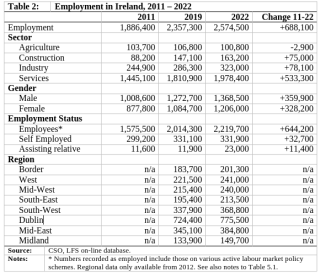
The consequence of the 2009-2013 crisis period job losses was a sharp increase in unemployment and emigration which took some time to dissipate. Dealing with unemployment, Table 3 shows how it has changed between 2011 and 2022, a period when the numbers unemployed decreased by 67 per cent. As the table shows, male unemployment fell by almost 160,000 and female unemployment by 70,000; changes that illustrate the depth of that economic crisis. Most of the 2022 unemployed are seeking to return to a full-time (FT) job with just over 25 per cent indicating that they were seeking part-time (PT) employment.
The improvement in the number and rates of long-term unemployment are also highlighted in Table 3 and in Chart 1. The number of long-term unemployed exceed 200,000 in 2011 but had fallen to less than 40,000 by late 2019. The 2022 figure, of 34,300 is the lowest LT unemployment count since 2007 and implies that just under one-third of all those currently unemployed are in that situation for more than one year. While the improvements over the last decade are very welcome, the experience of the 1980s showed the dangers and long-lasting implications of large numbers of people trapped in long-term unemployment. While this remains a policy challenge, Social Justice Ireland regrets that it is a policy area which receives limited attention.
Addressing this ongoing issue remains an important challenge and we outline our suggestions for targeted policy action later. However, it is clear that reskilling many of the unemployed,in particular those with low education levels, will be a key component of the response. Using data for the fourth quarter of 2022, 42 per cent of the unemployed had no more than second level education with 14 per cent not having completed more than lower secondary (equivalent to the junior certificate).
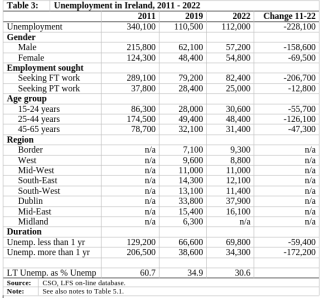
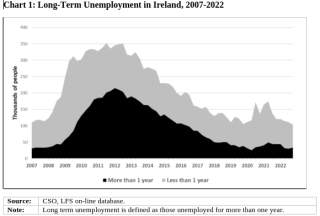
Upskilling and Retraining the Unemployed
Live register data offer a useful insight into the skills and experience of a large proportion of those who should be the target of further upskilling and retraining initiatives. Table 4 presents a breakdown of the February 2023 live register number by people’s last occupation, and also examines the differences between those over and under 25 years. Among this group, the figures highlight the need for targeted retraining of people who hold skills having worked in sectors such as craft, clerical and plant/machinery work. As such, they frame several of the challenges for upskilling and retraining of many unemployed and underemployed individuals.
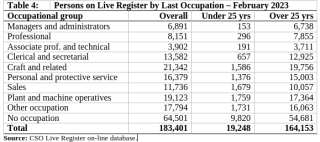
Given the current strength of the labour market, Social Justice Ireland believes that major emphasis should be placed on those who are trapped in long term unemployment – particularly those with the lowest education levels. Previous experiences, in Ireland and elsewhere, have shown that many of those under 25 and many of those over 55 find it challenging to return to employment after a period of unemployment. This highlights the danger of long-term unemployment and the potential for the emergence of a structural unemployment problem. Given this, Social Justice Ireland believes that a major commitment to retraining and re-skilling will be required in the years ahead.